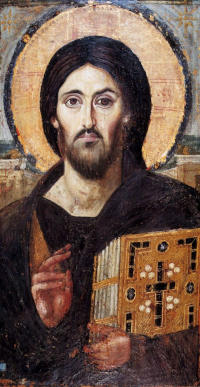Revelation
V. Conclusion

Christ Pantocrator
St. Catherine's Monastery
Sinai, Egypt
John lived in a world where every event, large or small, was caused by spirits, good or evil, so he wrote a fanciful work full of bizarre images that transversed heaven and earth. He both exhorted and admonished the Church in Asia Minor. He painted a a deadly battle of evil against the good, yet affirmed God’s immediate victory over Satan. He declared the Incarnation as the definitive revelation by God to humanity, then divided saved and the damned by faith in that event.
We must remember that the author lived in a time that had little value for human life. The Roman culture reveled in blood sport of gladiators, public executions and dangerous games of horse racing, even mock sea battles in arenas like the Colosseum. They ruled through brutal domination and subjugation. The maintained peace through corruption and heavy taxation. They held any group that practiced a counter-cultural lifestyle with suspicion and prejudice. John’s stark word-images reflected that injustice and brutality. He, like everyone else, didn’t even ask why life wasn’t fair; it just wasn’t. But, he did yearn for the freedom to evangelize, despite his exile on Patmos.
So, John wrote in a style shared an apocalyptic eschatological outlook with his fellow Jews, but addressed it to his fellow Christians. As some of those believers, we can begin to look anew at Revelation but through his eyes first, then ask: what does the book mean to us today? John addressed it to believers that suffered prejudice, even martyrdom for the faith. In our present world, more Christian face persecution that at any other time in history. Thus, his concerns are ours. Literally millions of the faithful cry out for God’s mercy and justice. They plead, “when, Lord, when will you save us?” While those who endure might not understand the author’s imagery, they immediately grasp his reasons for writing. They along with John’s audience pray in one voice, “Come, Lord Jesus.”
Marana tha. Amen.
Sources
Harrington, Daniel J. Revelation. Liturgical Press, 1993.
Bratcher, Robert G., and Howard Hatton. A Handbook on the Revelation to John. United Bible Societies, 1993.
Koester, Craig R.. The Apocalypse: Controversies and Meaning in Western History. Chantilly, Virginia: The Great Courses, 2011. Print.
Stergiou, Costas. TheWord.net. Computer software. Vers. 5.0. TheWord.net. 2015. 2015 <http://theword.net/>.
NET Bible. theWord.net module. The NET Bible. 2015 <https://netbible.com/>.
Novum Testamentum Graece. theWord.net module. Vers. NA27. <theWord.net>.
Photo Attribution
Christ Pantocrator. Anonymous Unknown author [Public domain]
